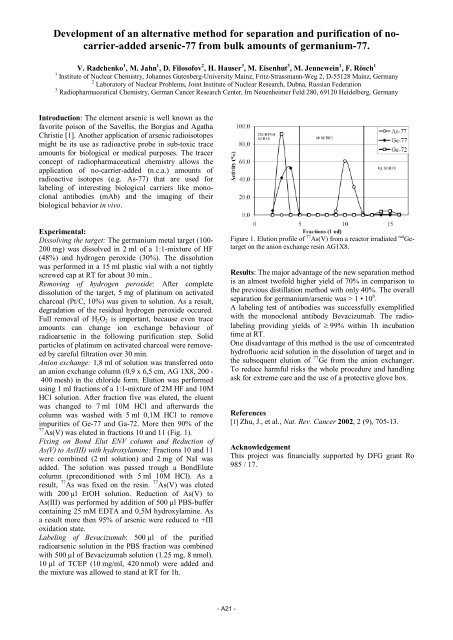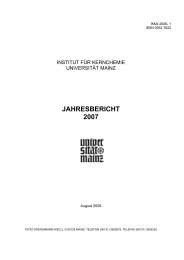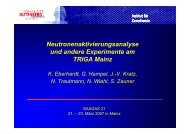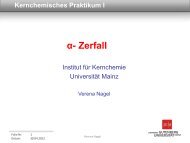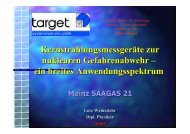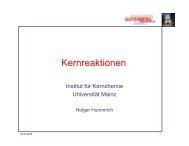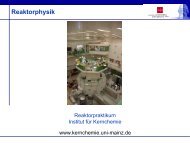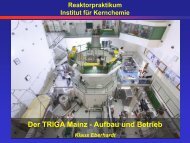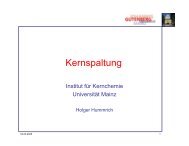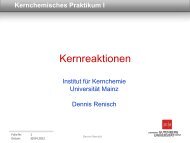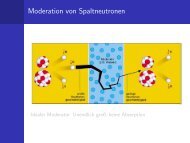institut für kernchemie universität mainz jahresbericht 2009
institut für kernchemie universität mainz jahresbericht 2009
institut für kernchemie universität mainz jahresbericht 2009
Create successful ePaper yourself
Turn your PDF publications into a flip-book with our unique Google optimized e-Paper software.
Development of an alternative method for separation and purification of nocarrier-added<br />
arsenic-77 from bulk amounts of germanium-77.<br />
V. Radchenko 1 , M. Jahn 1 , D. Filosofov 2 , H. Hauser 3 , M. Eisenhut 3 , M. Jennewein 1 , F. Rösch 1<br />
1 Institute of Nuclear Chemistry, Johannes Gutenberg-University Mainz, Fritz-Strassmann-Weg 2, D-55128 Mainz, Germany<br />
2 Laboratory of Nuclear Problems, Joint Institute of Nuclear Research, Dubna, Russian Federation<br />
3 Radiopharmaceutical Chemistry, German Cancer Research Center, Im Neuenheimer Feld 280, 69120 Heidelberg, Germany<br />
Introduction: The element arsenic is well known as the<br />
favorite poison of the Savellis, the Borgias and Agatha<br />
Christie [1]. Another application of arsenic radioisotopes<br />
might be its use as radioactive probe in sub-toxic trace<br />
amounts for biological or medical purposes. The tracer<br />
concept of radiopharmaceutical chemistry allows the<br />
application of no-carrier-added (n.c.a.) amounts of<br />
radioactive isotopes (e.g. As-77) that are used for<br />
labeling of interesting biological carriers like monoclonal<br />
antibodies (mAb) and the imaging of their<br />
biological behavior in vivo.<br />
Experimental:<br />
Dissolving the target: The germanium metal target (100-<br />
200 mg) was dissolved in 2 ml of a 1:1-mixture of HF<br />
(48%) and hydrogen peroxide (30%). The dissolution<br />
was performed in a 15 ml plastic vial with a not tightly<br />
screwed cap at RT for about 30 min..<br />
Removing of hydrogen peroxide: After complete<br />
dissolution of the target, 5 mg of platinum on activated<br />
charcoal (Pt/C, 10%) was given to solution. As a result,<br />
degradation of the residual hydrogen peroxide occured.<br />
Full removal of H2O2 is important, because even trace<br />
amounts can change ion exchange behaviour of<br />
radioarsenic in the following purification step. Solid<br />
particles of platinum on activated charcoal were removeed<br />
by careful filtration over 30 min.<br />
Anion exchange: 1,8 ml of solution was transferred onto<br />
an anion exchange column (0,9 x 6,5 cm, AG 1X8, 200 -<br />
400 mesh) in the chloride form. Elution was performed<br />
using 1 ml fractions of a 1:1-mixture of 2M HF and 10M<br />
HCl solution. After fraction five was eluted, the eluent<br />
was changed to 7 ml 10M HCl and afterwards the<br />
column was washed with 5 ml 0,1M HCl to remove<br />
impurities of Ge-77 and Ga-72. More then 90% of the<br />
77 As(V) was eluted in fractions 10 and 11 (Fig. 1).<br />
Fixing on Bond Elut ENV column and Reduction of<br />
As(V) to As(III) with hydroxylamine: Fractions 10 and 11<br />
were combined (2 ml solution) and 2 mg of NaI was<br />
added. The solution was passed trough a BondElute<br />
column (preconditioned with 5 ml 10M HCl). As a<br />
result, 77 As was fixed on the resin. 77 As(V) was eluted<br />
with 200 µl EtOH solution. Reduction of As(V) to<br />
As(III) was performed by addition of 500 µl PBS-buffer<br />
containing 25 mM EDTA and 0,5M hydroxylamine. As<br />
a result more then 95% of arsenic were reduced to +III<br />
oxidation state.<br />
Labeling of Bevacizumab: 500 µl of the purified<br />
radioarsenic solution in the PBS fraction was combined<br />
with 500 µl of Bevacizumab solution (1.25 mg, 8 nmol).<br />
10 µl of TCEP (10 mg/ml, 420 nmol) were added and<br />
the mixture was allowed to stand at RT for 1h.<br />
Figure 1. Elution profile of 77 As(V) from a reactor irradiated nat Getarget<br />
on the anion exchange resin AG1X8.<br />
Results: The major advantage of the new separation method<br />
is an almost twofold higher yield of 70% in comparison to<br />
the previous distillation method with only 40%. The overall<br />
separation for germanium/arsenic was > 1 10 6 .<br />
A labeling test of antibodies was successfully exemplified<br />
with the monoclonal antibody Bevacizumab. The radiolabeling<br />
providing yields of � 99% within 1h incubation<br />
time at RT.<br />
One disadvantage of this method is the use of concentrated<br />
hydrofluoric acid solution in the dissolution of target and in<br />
the subsequent elution of 77 Ge from the anion exchanger.<br />
To reduce harmful risks the whole procedure and handling<br />
ask for extreme care and the use of a protective glove box.<br />
References<br />
[1] Zhu, J., et al., Nat. Rev. Cancer 2002, 2 (9), 705-13.<br />
Acknowledgement<br />
This project was financially supported by DFG grant Ro<br />
985 / 17.


